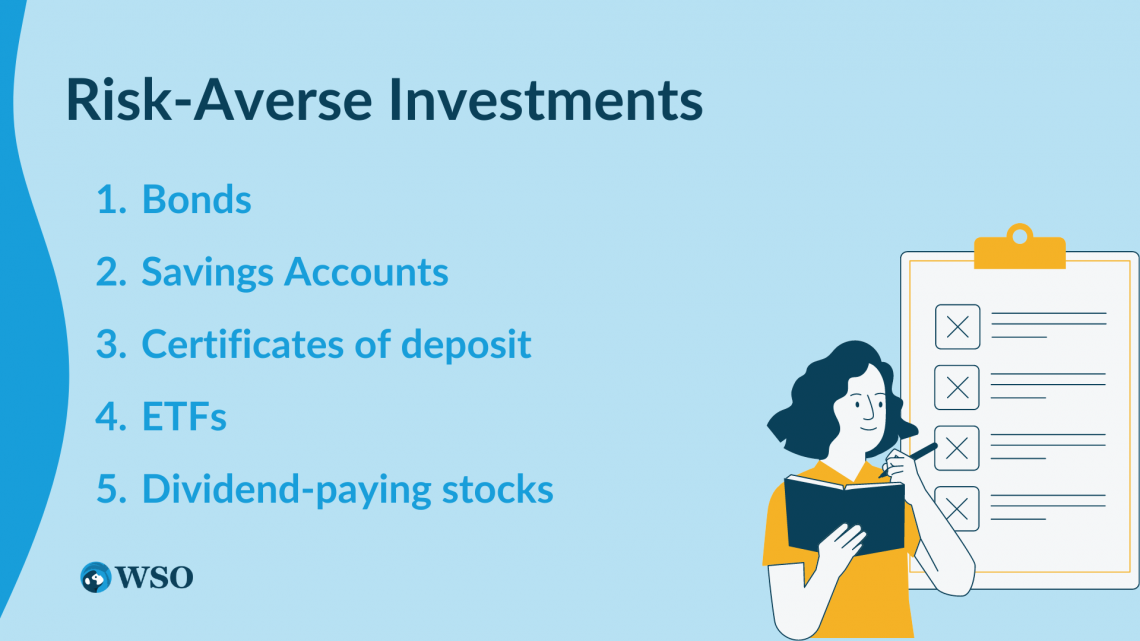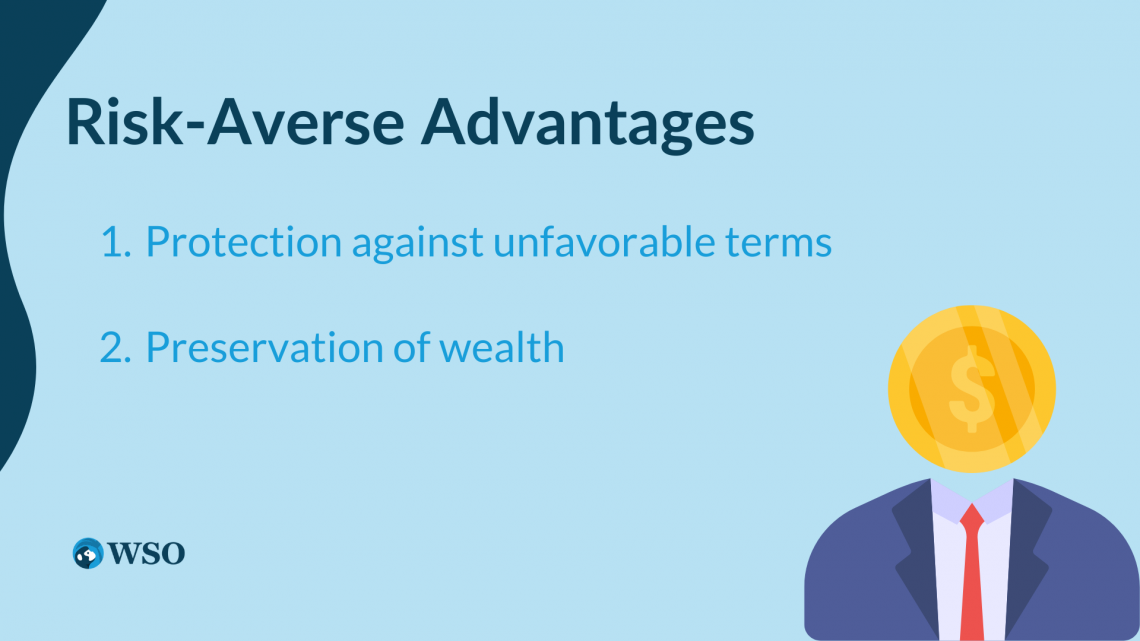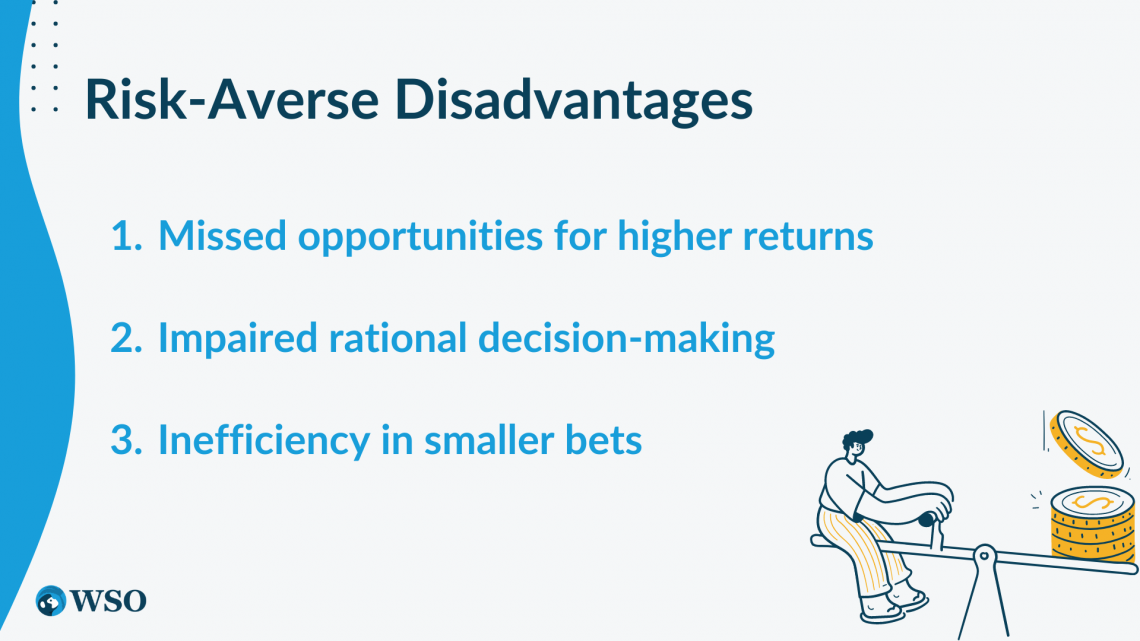Risk Averse Definition
Risk Averse is a behavioral tendency wherein individuals or investors exhibit a preference for lower-risk options, prioritizing capital protection over potential gains.
Risk-averse is an adjective that describes people who prefer to avoid risk. These people are inclined towards investments and opportunities with low possibilities of loss or failure.

In the context of the financial world, this trait can be seen in investors who prefer safer investments over risky assets, even if they offer lower rates of return.
This behavior is closely related to the concept of risk premium, which describes the higher rate of return offered on riskier assets to compensate investors for undertaking the additional uncertainty.
Risk-averse individuals will only undertake risky opportunities with a significantly high-risk premium.
For example, stock prices have historically fluctuated more than bond prices because they are less secure. Consequently, stocks have a risk premium for the extra risk associated with them, promising higher potential returns for their increased risk.
Stocks with higher volatility on the stock market have the potential to produce bigger gains but also higher losses. This risk is captured by the beta financial metric, which describes a stock's relative volatility compared to the general market.
Beta values above one indicate that a stock is more volatile than the market as a whole. Meanwhile, beta values below one indicate that a stock is less volatile.

However, stocks with low betas also have a lower chance of achieving high returns because they have historically shown stability.
On the other hand, investments with higher risk may yield substantial returns but also carry a significant chance of loss. Therefore, for risk-averse people, safer assets with virtually guaranteed returns are more attractive due to their improved security.

Risk-averse is often confused with loss averse, but they are fundamentally different. While people of the former nature tend to avoid risky activities in general, the latter may undertake risk to prevent loss.
Let’s consider an example. Two people must pick between losing $1,000 for certain or losing $500 with a 50% possibility of losing $1,500. One of the two is risk averse, while the other is loss averse.
The one who is risk averse will likely choose the first option, taking the $1,000 loss because it offers certainty for a relatively positive outcome.
However, the second individual will likely choose to take the chance to reduce their losses. Because they are loss averse, they prioritize minimizing losses, even if they come at increased risk.
Key Takeaways
- Risk-averse individuals tend to avoid risky activities.
- People with this characteristic are typically older and seek to maintain wealth overgrowth.
- Assets with a low-risk offer lower returns than risky assets but are more stable and secure.
- Risk is measured by beta in the stock market, which refers to the volatility of a stock compared to the general market.
- Risk-averse investments include bonds, savings accounts, certificates of deposit, ETFs, dividend-paying stocks, and more.
- Avoiding risk can protect against losses but also hinder rational decision-making regarding favorable investments with reasonable risk.
- The insurance industry caters to risk-averse people who prefer the safety of knowing that they would not suffer a major loss.
What is risk averse?
Risk-averse describes the tendency to avoid risk even when it offers a potential for a high return. This characteristic is commonly shown in older investors, who tend to prioritize the security of their wealth rather than seeking to gain new wealth.

A general rule of thumb to determine the allocation of higher-risk assets, such as equities, in a portfolio is to subtract one's age from 110. For example, if you are 30, you should keep 80% of your portfolio in stocks (110-30=80).
This rule reflects that younger investors can afford to be more ambitious in their investments because they have a lifetime ahead of them. Meanwhile, older investors who already have wealth typically focus on maintaining that wealth.
However, it is important to determine your risk tolerance beforehand since that allocation does not apply to everyone. You can take assessments online to assess your risk tolerance.
On the opposite end of the spectrum, risk-seeking individuals are described as having a high-risk tolerance and being willing to undertake risks in pursuit of high returns.
These people are typically younger investors who are willing to bet big for a chance to earn exceptional returns. Investments that appeal to these people often carry a lot of risks but can produce returns many times the market return.

In addition to stocks with high betas, these high-return investments can include cryptocurrencies, options, and more. However, the volatility of these instruments can produce significant returns and risk, as shown by the cryptocurrency growth and decline in 2021-2022.
To mitigate risk, you can diversify your assets among different asset classes to minimize the covariance between your investments. Investing in various instruments makes the risk that your entire portfolio will decline lessened.
You can do this by purchasing a combination of stocks, bonds, and commodities while diversifying within each category. In addition, you can adjust the balance of these categories within your portfolio to match your risk preference.
Risk-averse investments
For risk-averse people, various investment options can produce revenue for a low risk. However, these instruments will yield lower returns that typically match or barely exceed the inflation rate.

1. Bonds
Bonds are debt instruments issued by municipal and corporate entities. They are practically certain to be reimbursed, making this investment very low risk. As a result, credit rating agencies give the most secure bonds the AAA rating.
Savings accounts allow you to earn interest on funds deposited in them, which can be withdrawn up to a monthly limit. The Federal Deposit Insurance Corporation insures these accounts up to a quarter of a million dollars ($250,000).
3. Certificates of deposit
Certificates of deposit (CD) act like savings accounts, except they have stricter withdrawal limits. Typically, the amount placed in these instruments is not accessible for a predetermined period of time. However, they issue a higher return than savings accounts.
4. ETFs
ETFs that track market indexes are typically safe because they track a broad, diversified group of stocks. This allows it to achieve lower volatility than individual stocks while providing a fraction of their potential returns.
5. Dividend-paying stocks
Dividend-paying stocks are typically mature companies that have an established and reputable brand. As a result, these companies are safer than their younger alternatives, which may experience greater uncertainty during their growth.
NOTE
No investment is completely risk-free, even though some have exceptionally low risk.
Of these options, the safest investments are bonds, savings accounts, and certificates of deposit. However, government bonds are guaranteed to be paid back unless the government defaults, implying that this asset's risk can vary from country to country.
United States treasury bonds are often regarded as secure because there is less risk of default here.
Similarly, corporate bonds are guaranteed to be paid back unless the company goes bankrupt, in which case bonds are still prioritized. When the company is liquidated, its assets are sold to repay bonds first before paying shareholders.
Savings accounts and certificates of deposit are also considered safe because they are placed in trusted institutions with almost negligible risk.
Risk-averse advantages and disadvantages
Being risk averse has various advantages and disadvantages because avoiding risk can help you avoid excessive gambles with exorbitant amounts of money. Still, it can also deter you from making rational decisions with reasonable risk. The advantages are:

1. Protection against unfavorable terms
Avoiding risk can act as a natural defense mechanism that protects individuals from unfavorable terms. It reduces the likelihood of making impulsive decisions that could lead to significant financial loss.
2. Preservation of wealth
It can preserve wealth by limiting the possibility of loss, which is especially beneficial to retirees who can already live in comfort. By prioritizing the security of their wealth, they can maintain their standard of living and financial stability.
The disadvantages are:

1. Missed opportunities for higher returns
One of the drawbacks of being risk averse is the potential to miss out on higher returns that often come with greater risk.
2. Impaired rational decision-making
Risk aversion can even impair rational decision-making if the terms are favorable. Consider the case below.
Assume you're allowed to bet on the flip of a coin. If it comes up heads, you earn $200. But if tails come up, you lose $100. Given the 50% chance of financial loss, risk-averse people would pass on this offer.
However, this is a favorable offer if you analyze it statistically. With 50% of the time earning $200 and 50% of the time losing $100, you get an expected value of earning $50. People who avoid risk may turn down this offer due to excessive risk aversion.
3. Inefficiency in smaller bets
Risk aversion can lead to inefficient decision-making, especially in situations involving relatively small bets or low-cost risks.
People may opt for unnecessary precautions or insurance, even when the likelihood of loss is minimal, and the cost of potential damage or loss is low.
This excessive risk aversion can result in unnecessary expenses and missed opportunities for savings.
For example, people purchase insurance for their phones even though there is little possibility of damage and a low cost of replacing it.

Continuing with the coin flip example, the result changes when the bets become larger. Imagine if the same coin flip was offered a thousand times.
Knowing that earning $50 per flip is an expected value, most people would take the deal because it is significantly more likely to produce a positive profit.
As shown, even when met with a statistically favorable offer, people who avoid risk tend to turn down these offers due to their uncertainty, however small.
This puts them at a disadvantage because they can potentially miss out on favorable opportunities with reasonable risk.
What is an example of risk-averse behavior?
The insurance industry appeals to risk-averse individuals because they provide safety in the form of knowing what the outcome would be. For example, car insurance protects against accidents by reassuring individuals that their damages would be limited.

Let’s consider how this would affect consumers’ decision-making. Without car insurance, let’s assume there is a 5% chance of an accident and that it would cost $20,000 in repairs if it happens.
In addition, assume that insurance costs $2,000 per year and covers the entire cost of any accident. Statistically speaking, the insurance is only worth purchasing if the chances of getting in an accident are 10% (2,000/20,000).
However, risk-averse individuals may choose to purchase the insurance regardless to protect against the possibility that they get in an accident. By purchasing insurance, they substitute the 5% risk of a $20,000 accident for a guaranteed loss of $2,000 per year.
This is an example of a risk-averse behavior in which someone demonstrates their reluctance to risk by acting to mitigate the effects of that risk.
It is worth noting that insurance can introduce moral hazard, which refers to the reduced incentive to protect against risk due to the knowledge that the insurance company will cover the losses.

In the insurance context, moral hazard can be illustrated by more reckless actions due to the knowledge that the insurance company would pay for accidents.
For example, someone who has purchased home insurance may be less vigilant to protect against threats such as fires. In fact, some may even change their actions to be less than cautious about risk-taking.
Someone with home insurance may decide to light their own house on fire to claim home insurance. However, this is arson. Therefore, your claim will be nullified because it is against criminal law to knowingly and purposely set property on fire.
Let’s go back to the car insurance example. Moral hazard in this situation can occur in the form of more reckless driving due to the knowledge that accidents would be paid for. However, it is important to note that moral hazards can impact everyone negatively.
When the number of accidents increases because of a greater rashness among the insured, the price of insurance will increase so that insurance companies can afford to cover these additional accidents.
These increased costs are passed on to all policyholders through higher insurance premiums, impacting everyone's financial burden.




or Want to Sign up with your social account?